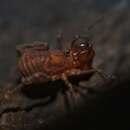Diagnostic Description
provided by EOL authors
Eyemound rising directly from the anterior margin of the carapace, usually smooth and rounded, sometimes with a small apical tubercle or produced forward. Scute including the anterior margin of the carapace without prominent tubercles or pustules. Tergal areas not defined. Legs unarmed, calcaneus much shorter than astragalus and never notched. Tarsal formula 3-4, 5-15, 4, 4 (some species with four segments to tarsus I, in male, but three in female). Side branches of claws 3 and 4 much smaller and weaker than median prong. Both sexual and male dimorphism present (Forster 1954).
Distribution
provided by EOL authors
Nuncia are found in Australia and are widespread across the islands of New Zealand, from Stewart Island, through the South Island, to the North Island. Five species have been described between Chile and Argentina: Nuncia Americana Roewer, 1961, Nuncia chilensis (Soares, 1968), Nuncia spinulosa Maury, 1990, Nuncia verrucosa Maury, 1990, and Nuncia verrucosa Maury 1990, although their placement within Nuncia awaits confirmation by further morphological and molecular studies.
Habitat
provided by EOL authors
Like all Triaenonychidae, members of the genus Nuncia are nocturnal predators. During the daytime they hide underneath logs and rocks. They are also found in large numbers in the leaf litter under the forest canopy. They are very sensitive to humidity of the substrate which they inhabit, and are found in the drier areas of very moist forests, and the wetter areas of dry forests.
Taxonomy
provided by EOL authors
1899 Triaenonyx (Part) Simon, Zool. Jahrb. Syst. l2, pA31.
1902 Nuncia Loman, Zool. Jahrb. Syst., 16. p.213.
1903 Triaenonyx (Part) Pocock, Proc. ZooI. Soc. London.
1903 Nuncia Pocock, Ann. Mag. Nat. Hist. Ser.7 (II), pA45.
1915 Nuncia Roewer, Arch. Naturg, 80 A (12); p.76.
1915 Metanuncia Roewer ibid. p.101.
1920 Triaenonyx (Part) Hogg, Proc. ZooI. Soc. London, p.38.
1920 Nuncia Hogg ibid. pA1.
1923 Nuncia Roewer, Die Weberknechte der Erde, p.591.
1923 Metanuncia, Roewer ibid. p.602.
1932 Triaenonyx (Part) Phillipps and Grimmett, Proc.ZooI.Soc., London, p.735.
Brief Summary
provided by EOL authors
The genus Nuncia is the most common Harvestman found in the forests of New Zealand. Like all members of the family Triaenonychidae, all Nuncia have enlarged palpi ornamented with spikes, hairs and tubercles. This contrasts with many other harvestmen, e.g. the family Monoscutidae, whose members have enlarged and ornamented chelicerae instead (the chelicerae are the first pair of appendages, while palpi are the second).
Like all harvestmen (save a few exceptions), Nuncia has its eyes on a eyemound, but in Nuncia this eyemound is never ornamented with spikes, save some species of Nuncia which have a very small tubercle. Otherwise the eyemound is completely smooth. The eyemound of Nuncia is also always flush with the anterior part of the carapace (the plate covering the anterior part of the animal), also never having spikes in the area, unlike otherwise much of the diversity inside Triaenonychidae shows. While some Nuncia have a carapace with leathery appearance and some pustules, by and large the carapace and body of Nuncia is also characteristically smooth.
Phylogenetic relationships
provided by EOL authors
While there is little doubt as to the placement of Nuncia within Triaenonychidae based on molecular and morphological characters, the relationships of the genera inside the family remain uncertain and unstudied (Giribet et al. 2002; Giribet et al. 1999; Giribet et al. 2010).

